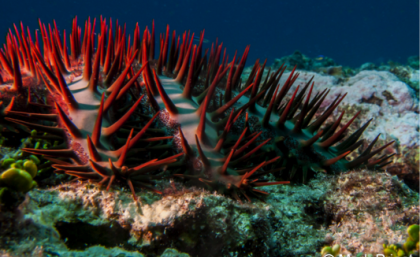
Predicting the patterns of crown-of-thorns starfish outbreaks is the focus of a University of Queensland study that could be vital to protecting the Great Barrier Reef.
The study, led by Dr Karlo Hock and co-authored by Professor Peter Mumby, both from UQ’s School of Biological Sciences, has shown that the world’s largest reef structure is particularly prone to damaging and extensive outbreaks of the voracious coral-eating starfish because it functions as a well-connected series of small reefs.
Dr Hock said large-scale starfish infestations could be attributed to outbreaks that started on particular reefs in areas where these outbreaks could be passed on to many other reefs.
“Starfish larvae carried on ocean currents can intensify these smaller outbreaks and start new outbreaks elsewhere and spread the infestation over vast areas,” he said.
“While the local impacts of a starfish outbreak can be devastating, the real threat to the reef is the specific pattern of larval transport that makes it susceptible to large-scale infestations.”
These infestations can then threaten the ecological and economic sustainability of the reef and its $5 billion tourism and fishing industries.
To further this research, the Queensland Government has awarded a$491,000 Accelerate Partnerships grant to Professor Mumby’s lab and several non-UQ partners to coordinate a strategy to address the looming crown-of-thorns starfish problem.
Dr Hock said crown-of-thorns starfish populations undergo periodic local booms that seriously deplete coral from reefs and these outbreaks can turn into a reef-wide plague.
“On the Great Barrier Reef, the same reefs that can intensify local outbreaks also happen to be those that can then turn local outbreaks into a wider problem: a starfish epidemic,” he said.
Professor Peter Mumby said the team had discovered that the reefs that could start the chain reaction of outbreaks were in the same regions where large-scale starfish epidemics had historically originated.
“This information helps us understand which of the 3000 reefs to monitor and, with the starfish outbreaks on the rise, will play a vital role in proposing carefully targeted measures to control starfish epidemics,” he said.
“The Accelerate Partnerships project’s whole-of-system approach will address the root causes of starfish outbreaks, such as land use practices and cyclones, and recommend viable strategies for both immediate and long-term control solutions.”
Dr Hock and Professor Mumby said the key outcome of the project would be the development of dynamic, real-time risk maps to highlight reefs vulnerable to starfish outbreaks and recommend actions that would make the control efforts more effective and efficient.
The research was done in collaboration with CSIRO’s Dr Scott Condie from CSIRO and the Australian Institute of Marine Science’s (AIMS) Dr Ken Anthony, and published in the Journal of Applied Ecology.
The Accelerate Partnerships partners are AIMS, the Great Barrier Reef Marine Park Authority, James Cook University, Queensland Parks and Wildlife Service, Association of Marine Parks Tour Operators, Reef and Rainforest Research Centre and Terrain Natural Resource Management Group.
Media: Dr Karlo Hock, +61 (0) 7 3365 1671, Mobile: +61 451 585 138 k.hock1@uq.edu.au; Prof Peter J. Mumby, Mobile: +61 449 811 589, p.j.mumby@uq.edu.au
.jpg)










